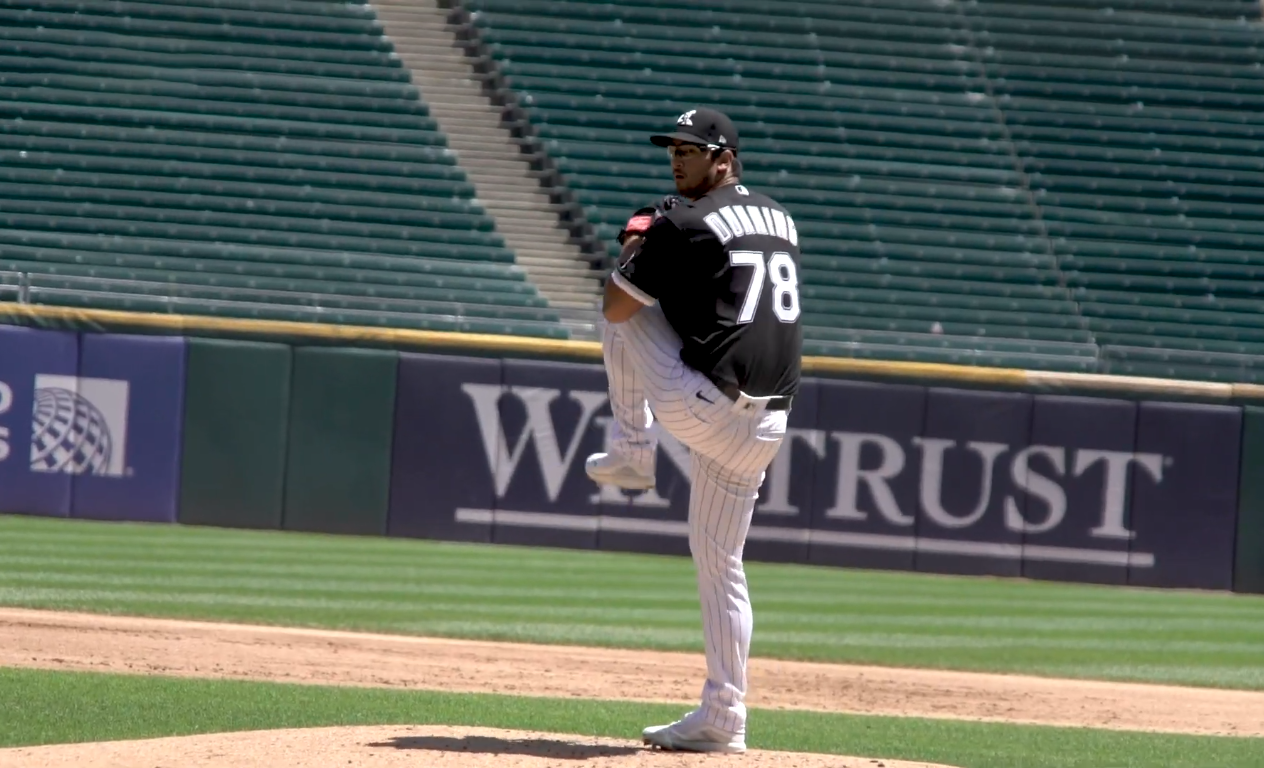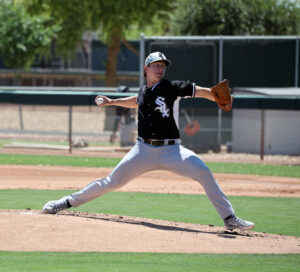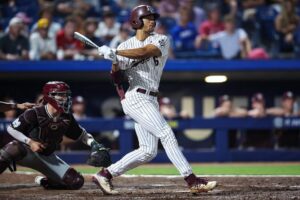White Sox rookie review: Dane Dunning

Dane Dunning during a Summer Camp intrasquad game (July 12th, 2020) - (Credit: YouTube Video Still)
Despite there being no minor league season in 2020, there was a significant number of White Sox prospects who made big strides. The White Sox had 12 players make their MLB debuts. We are taking a look back at how they fared and what it means for their future. Dane Dunning is the second player on our list, following Luis Robert.
RELEVANT STATS
Regular Season: 34.0 IP, 3.97 ERA, 35 K, 13 BB, 25 H (7 starts)
Postseason: 0.2 IP, 0 R, 0 K, 0 BB, 2 H (1 start)
FROM SIDE-SESSIONS TO THE BIG LEAGUES
Few minor league pitchers received as much site-space on FutureSox in 2020 as Dane Dunning. No fewer than seven times was the right-hander the focus of one of our articles. The year opened with cautiously optimistic news regarding Dunning’s surgically repaired elbow in February, right before Spring Training. After the COVID-19 pandemic wreaked havoc on the scheduled season, and teams started Summer Camp at their home ballparks, reports on Dunning were even more positive.
On July 13, FutureSox noted that Dunning looked ready to contribute, in any way necessary. We followed that up with a conclusion on August 5 that Dunning would see the majors in 2020. The 25-year-old himself told FutureSox’ Ken Sawilchik a few days later that he would be ready when needed. Thirteen days later, after Jonathan Stiever had already made his first successful MLB start, Dunning was indeed called up.
READY WHEN CALLED UPON
Like Stiever before him, Dunning was also tasked with facing the diminutive Detroit Tigers. Still, despite not battling the greatest of major league lineups in 2020, the former Gator impressed. It was no small feat of Dunning to keep his nerves under control. He went toe-to-toe with one of the top pitching prospects in the game in Casey Mize, who also happened to be making his MLB debut.
Dunning and Mize delivered on the pre-game hype, as both right-handers reeled off similar stat lines. Dunning went 4.1 innings, struck out seven Tigers and walked only one. He gave up five hits and three earned runs, all coming on a three-run home run by the final batter he faced, Jeimer Candelario. Mize’s line, just because it’s so similar: 4.1 IP, 3 ER, 7 K, 0 BB, 7 H. Both pitchers exited after having thrown 73 pitches as well.
Dunning’s good run included striking out the side in the third inning, and he got five of his seven Ks on swinging strikes, proving just how good his breaking stuff can be when it’s on.
START OF A GOOD THING
Eleven days later, Dunning got his second big league start, this time against the Kansas City Royals. He one-upped himself by keeping KC hitless, striking out seven batters in the process and walking just one. Dunning looked in control and kept the opposition of balance with a great mix of fastballs, sinkers and breaking balls.
The two starts were the beginning of an impressive stretch for Dunning, as he pitched well enough to earn another five starts on top of the first two. After a 4.2 IP, 3 ER, 4 BB, 4 K affair in his second go-around against KC, Dunning threw two of his best games of the season in succession. He blanked the Pirates for six innings (3 H, 1 BB, 3 K), before completely befuddling the very tough Minnesota Twins offense: 7.0 IP, 3 H, 2 R (1 ER), 2 BB, 7 K on 102 pitches. Though only seven of his 62 strikes were of the swinging variety, Dunning was able to paint corners and got 20 called strikes from umpire Will Little.
Interestingly enough, Dunning’s pitch distribution in his best start of the season mimicked his overall pitch distribution almost to a ‘T’ (season % in parenthesis): 42% (39.4%) sinkers, 22% (21.7%) sliders, 19% (21%) four-seamers, 13% (11%) changeups, 5% (6.8%) curves. Take that for what it’s worth.
TIRED TOWARDS THE END
Dunning ended his regular season, clearly tired, with two mediocre starts. He gave up a total of eight earned runs in seven innings against the Indians and Cubs (including a grand slam to Kris Bryant), but he continued to throw strikes (4:7 BB/K). All in all, he had pitched well enough that Ricky Renteria anointed Dunning the Game 3 starter in the AL Wild Card series against the Athletics.
Dunning struggled a little, giving up two hits in the first inning before Renteria pulled him for Garrett Crochet. We all remember what unfolded after that. Despite the quick hook and the two hits, Dunning continued what he had been doing all season, and that was throwing strikes. 10 of his 15 pitches ended up a strike — though only one was a swinging strike. Still, Dunning delivered multiple times when the Sox needed him, during this strange, yet successful season.
GOING FORWARD
All superlatives aside — and Dunning earned plenty — there were a few underlying issues that the young right-hander may want to work on or take a look at. While keeping in mind that he only pitched 34 innings, so the sample size is small, the most eye-popping of the perhaps eventually problematic issues is his spin rate. According to Statcast, Dunning rates as ‘poor’ in fastball and curveball spin; data that in this day and age more often than not indicate how sustainable a pitcher’s success is. The mediocre 54% Whiff% is another element where you’d wish to see a higher number. It doesn’t have to be Lucas Giolito’s insane 94%, but still.

Dunning does rely on his four-seamer a lot less than other pitchers with his arsenal may do. In 2020, he threw almost 40% sinkers, in an effort to keep the ball on the ground. He succeeded in that regard, though the 45.1% groundball rate was lower than his minor league career. He also fared much better against right-handers than against left-handers, more than doubling his ERA and WHIP from one to the other. That could stem from the fact that Dunning threw only 11% changeups, a pitch known to be a potential weapon for right-handed pitchers against lefty hitters. Once he further develops and implements the changeup as a viable pitch, and combined with an already nasty slider, these numbers should be expected to improve.
Despite coming into the season as somewhat of an unknown due to injury status and rehabilitation, Dunning did everything and more to cement a spot on the big league team for 2021 and beyond. Let’s not forget: this was a pitcher coming off of Tommy John surgery, who had not yet pitched above Double-A. Dunning showed the White Sox plenty to build on. He should be firmly in contention for a spot in the rotation for next season.
Image credit: YouTube video still
Want to know right away when we publish a new article? Type your email address in the box on the right-side bar (or at the bottom on a mobile device) and click create subscription. Our list is completely spam free, and you can opt out at any time. Also, consider supporting FutureSox on Patreon! You can get early access to special articles and Patreon-only posts, in addition to more benefits.
Shop our exclusive merchandise! Show your support with FutureSox apparel.







2 thoughts on “White Sox rookie review: Dane Dunning”
Comments are closed.